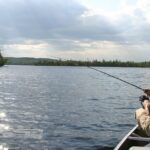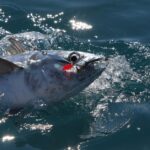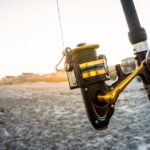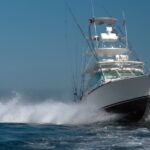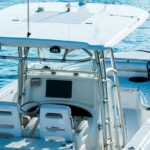If you watch fishing shows, you’ve probably seen offshore anglers testing their mettle against massive marlins and tuna while pulling multiple lines behind their boat. But did you know that you could troll on a quiet lake with a canoe? Trolling is one of several popular ways of catching fresh and saltwater fish, but is trolling a good way to fish?
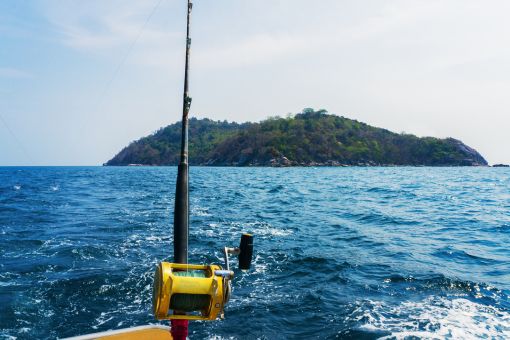
Trolling is an excellent method for catching several fresh and saltwater fish species. It allows you to set multiple lines and cover extensive sections of water. However, trolling has some limitations, particularly in the type of fish available and the additional equipment required.
While trolling is not everyone’s cup of tea, it is an effective and fun way to get outdoors and put your line in the water! Below we’ll take a “deeper” look at what makes trolling good and bad, some trolling gear and techniques to improve your chances, which fish species you target, and how it compares to other fishing styles.
Why Is Trolling An Effective Fishing Method?
Trolling is one of the most effective fishing styles that has been around for centuries. While the equipment has undergone some drastic technological advancements, the principle has remained (more or less) the same.
Get on a vessel, head onto the water, throw your fishing lines out behind you, and drag them along until a fish bites. At its core, trolling keeps the bait moving to appear attractive to fish.
The benefit of trolling is the amount of water you cover. Covering a larger area quicker increases the probability that fish find the bait. Another benefit is that you can troll in almost any water body.
However, like any other fishing technique/style, trolling has different characteristics depending on the target species and the environmental conditions.
Sometimes it’s slow, other times fast. You might have one or many lines in shallow or deep water, fresh or salt.
Successful trolling depends significantly on your gear and technique, as a poor technique or incorrect gear can severely reduce your efficacy (fish get away or don’t take the bait).
The Gear And Technique Used Are Critical To Trolling Success
Your gear and technique change according to the fish you’re targeting, the water body, and the environmental conditions (wind, temperature, current, etc.).
The Gear Required For Trolling
Firstly, you’ll need a vessel for trolling. Fortunately, tolling is not limited to large boats.
Practically anything that moves on the water is suitable for trolling, including:
- Kayaks and canoes
- Jon boats
- Skiffs
- Rubber ducks
- Sea cruisers (medium sea-going vessels)
- Larger boats (up to 98 feet) are usually commercial vessels custom-built for trolling.
Many anglers prefer using a braided line or wire for the massive fish that take the bait while trolling offshore. However, if you don’t plan on supersized fish, a monofilament line will serve you well (some anglers have a braid leader with mono backing).
When fishing in a freshwater environment, a 20 to 30-lb monofilament line works well (however, it has more stretch and might move around the surface more than a braid which is more “solid”).
Having enough length of fishing line is another essential consideration for trolling. Although it varies on where you troll, you’ll want a minimum of 150 yards of fishing line for freshwater trolling and around 800 yards for offshore fishing (although if you troll at around 7 to 8 mph, you’ll only need around 600 yards of line).
When trolling, you want your gear to do as much work as possible, so high-action lures are optimal. That isn’t to say that more “stationary” lures won’t work, but lures that dive and wobble about are generally better.
Many anglers prefer live- or cut-bait when trolling as it releases the correct scent, looks right, and moves desirably.
If you use the incorrect gear (weak line, wrong-sized rod), you hamper your success rates as you’ll contest with broken equipment and fish that escape.

Technique Plays An Essential Role In Effective Trolling
Without the correct technique, trolling is not as effective as it should be.
Although it’s not a complicated fishing method, mastering certain elements drastically improves your success rate.
Some pointers to improve the success rate include:
- Trolling shouldn’t feel like mowing the lawn for you or the fish! While trolling, try avoiding straight lines to and fro across the water body. Instead, make zigzag patterns.
The benefit is that when you turn one way, the lures on the side that you turn slow down, with the opposite side speeding up. Additionally, grabbing a line and giving it a yank is a great way to break the monotony of the boat’s motion (encouraging fish to strike).
- Aside from zigzagging, trolling in a cross-current direction produces the best results. Fish swim against the current in rivers, while marine fish swim with the tide. Cutting across the current is the best way to put your bait in front of as many fish as possible.
Turning with a wide enough arc is critical to avoid tangling your lines.
- It would be best to adapt your speed to the fish and lures. While certain fish are “predictable,” environmental factors might influence their activity levels. You should increase or decrease speed if you’re getting fewer bites.
The speed you travel depends on the target fish, the current strength, the wind, and the lure you use. Some lures perform better at higher/lower speeds.
- If you’re using one line (like when on a kayak in a smaller river) and struggling, try adjusting the distance until you get more frequent bites.
- If you’re using multiple lines, try staggering your lines’ distance from the boat and their depths in the water column to be effective (particularly when fishing offshore). By staggering your lines, you “cover” more water in one passing.
- The time of day you troll impacts your success. Fish tend to move up the water column during low light conditions and dive deeper as the day gets lighter. You increase the success rate by timing your trolling to early morning or evening.
Experience is essential to successful trolling; however, you’ll only become experienced through practice. It is a wondrous idea to keep a log book (or add waypoints to your GPS) of where fish strike so that you can start recognizing patterns and behavior of the various species.
Why Do Anglers Troll?
Many commercial and recreational anglers use trolling when fishing because it is incredibly effective in catching the type of fish they target, specifically large offshore species like marlins, sailfish, and tuna.
Trolling puts anglers in a range of fish habitats otherwise unreachable by other fishing methods. I.e., because you troll from behind a vessel, you can access deeper areas in the middle of a wide river or lake or offshore in the ocean that you’d otherwise not be able to reach.
Thanks to the constant movement of the vessel, trolling covers a larger area of the water body than other fishing techniques.
This extra movement results in your bait receiving greater exposure to the water body, meaning you are more likely to “bump into” an interested fish than if you were stationary.
Additional Benefits Of Using Trolling To Fish
Aside from access to fish that you’d otherwise miss, trolling provides several other benefits, including:
Trolling Allows You To Get A Better Feel For A Water Body
While trolling, you move back and forth across an area. If you’re savvy, you’ll note where fish bite, where certain features are (especially in lakes and rivers), what the current does where, and other important details.
You can target those areas again on future attempts and, hopefully, improve your success rate.
You Can Troll In Most Seasons
Spring, summer, and fall are excellent seasons for trolling, although the target species and techniques may vary slightly.
While winter trolling is feasible in warmer regions, you won’t be able to troll if the water freezes over.
During the colder months (before everything freezes), trolling encourages lethargic fish to strike.
Trolling Allows You To Set Multiple Lines Simultaneously
While you can set multiple lines from the bank or a stationary boat, you can’t retrieve multiple lures simultaneously. However, trolling allows you to fish effectively with all your lines.
Lures with pronounced actions as you retrieve them are perfect for trolling as they continuously signal to fish that food is nearby.
Trolling Encourages Fish To Bite
Trolling (especially with multiple lines) allows anglers to target fish that would otherwise not give a fishing line a second thought. As certain lures drag in the water, they mimic a fish (often an injured fish).
One line passing might not be enough to stir a game fish; however, multiple lines passing through the area (from additional lines) often provoke these fish to strike.
Trolling Keeps The Lure/Bait In The Water For Longer
While other forms of fishing require cast and retrieval (particularly when using a lure), trolling allows you to keep the lure in the water at all times while still gaining the full benefit of the lure’s action (swimming motion).
The increased “uptime” equates to more exposure and, hopefully, more bites.
Trolling Is A Fantastic Way To Get Others Hooked On Fishing
Trolling might be the best solution if you’re trying to encourage friends or family members (especially children) to go fishing.
With a relatively high success rate, a boat ride, and the option to leave your rod and look at something else, trolling is a great introduction to fishing that many people enjoy and look forward to experiencing again.
What Are Some Of The Drawbacks Of Trolling
Although popular and effective, trolling is not without limitations and downsides.
Lines May Become Tangled
One of the more annoying drawbacks of trolling is that you risk tangling lines when you have multiple lines in the water.
Lines may become tangled when the following occurs:
- If you turn too sharply
- If the current is strong and you’re moving quickly
- If there is a strong wind
- If a large fish takes the line and swims sideways
Alternatively, your line might become tangled in obstacles (like sunken trees, dense vegetation, boulders/reefs, or other boat propellers), especially if you use deep diving lures in shallow areas.
You Might Not Catch Anything
Unfortunately, as with any fishing, you never have a 100% guaranteed success rate when trolling. Although you get your bait and hooks around more of the water body, many variables hinder successful troll fishing.
Fish are living organisms whose behavior changes under different circumstances. So if trolling worked one day, there are no guarantees that you’ll be successful (and especially not with the same species) another day.
In these instances, it’ll benefit you to try and change your approach to see if your fortunes change.
I.e., adjust the depth you’re trolling at, try jigging while trolling, or throw out another line. If there are still no bites, it might be worth water skiing.
Fish move up and down the water column depending on the amount of dissolved oxygen and the water temperature, so finding the “sweet spot” is essential and often challenging.
Trolling Requires Mastering Additional Equipment
While other fishing techniques require you to practice the technique until you’re an expert, trolling asks that and more.
When fishing, you generally need a rod, reel, and tackle; however, you’ll need some vessel when trolling.
As part of a trolling expedition, you’ll need to know how to operate a vessel in various environments and conditions while simultaneously looking after your lines in the water.
Extra equipment also costs extra, making trolling more expensive than casting a few nightcrawlers from the bank.
Trolling Often Catches Fish In Areas Other Than The Mouth
When several hooks drag through the water, the chances of hooking a fish through the body increase drastically.
Trolling Presents The Bait For A Limited Time
While the benefit of trolling is that you cover more “ground,” this benefit has an associated drawback. The bait moves quickly past the fish.
Although this movement is useful for encouraging certain fish to strike, you’ll miss many opportunities on days when fish are less energetic as the bait moves away too quickly. Unfortunately, this is a significant trade-off when trolling.
When Would You Use Trolling As A Fishing Method?
One of the many benefits of trolling is that you can apply the fishing method across any water body large enough to support a moving vessel.
Freshwater Trolling
Although trolling is almost synonymous with saltwater fishing, there are many instances where the technique benefits freshwater anglers.
Large rivers and lakes are prime trolling locations with sufficient space for cruising while trailing your bait between 20 and 150 feet.
Trolling is feasible at any depth that supports your vessel. I.e., if you want to troll in 60″ of water, it’s possible, provided you’re on a kayak/small craft.
While trolling in freshwater, you’ll generally use crankbaits, floating plugs, and soft plastic baits. Ideally, you want bait that imitates a swimming fish, like many lipped crankbaits.
Several live baits work well, especially using worms when trolling for trout.
Saltwater Trolling
While trolling is feasible (and effective) in freshwater, it truly shines in the offshore saltwater environment.
Inshore and offshore trolling require different gear, but they follow similar principles. Going further out or staying closer to shore depends on your target fish.
When trolling in saltwater, you’ll use various live and cut baits, including:
- Ballyhoo
- Mackerel
- Mullet
- Squid
Aside from live bait, various lures work incredibly well, including:
- Crankbaits/plugs
- Jerkbaits
- Jigs
- Skirted lures – these mimic bait fish and “jump” through the surface as you troll with them.
- Spoons
- Soft plastic lures
Popular Fish Caught While Trolling
One of the significant factors relating to how good trolling is is what fish species you’re targeting.
Not all fish in fresh/saltwater water bodies are caught while trolling.
Freshwater fish often caught while trolling include:
- Musky
- Pike
- Salmon (including chinook, coho, pink, and sockeye)
- Striped bass
- Trout (brown, lake, and rainbow)
- Walleyes

Saltwater fish most frequently caught while trolling include:
- Bluefish
- Kingfish
- Marlin (especially blue)
- Mackerel
- Northern Pike (Jacks)
- Sailfish
- Tuna
- Wahoo

Trolling Vs. Other Fishing Styles
The significant difference between trolling and other fishing methods is that trolling increases the likelihood of a fish coming into contact with your bait, provided you use the correct technique and gear.
Neither trolling nor the other fishing methods/styles are the “best” techniques in every situation. When trolling for certain fish that hide under piers, or submerged obstacles, you’ll struggle to entice them while trolling.
While trolling is incredibly effective in exposing your bait and lines to more water for longer, other techniques are well employed when you know where the fish are hiding and you must encourage them into the open.
Trolling works well for the intended species, and some anglers prefer it. The important thing is to select a method that you enjoy and that creates a desire to get out on the water.
Conclusion
Trolling is a popular method for catching fish because it is effective. Anglers target several fresh and saltwater fish species (including inshore and offshore) and cover larger water body areas than other fishing techniques promote. While trolling requires a vessel, you’re not limited to large boats, as kayaks and canoes work well. However, the only way that trolling is effective is through practice.
- Do You Need An Indicator For Nymph Fishing? - November 16, 2023
- Fishing Safety Tips For Families - September 25, 2023
- What Is The Best Time To Night Fish At A Lake? - September 18, 2023

